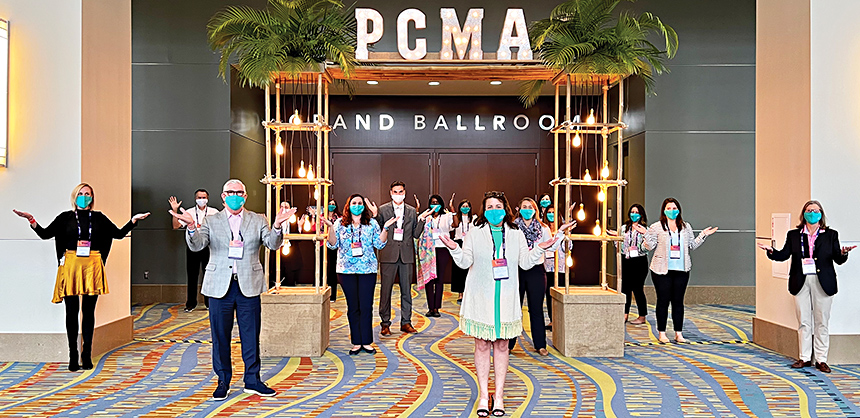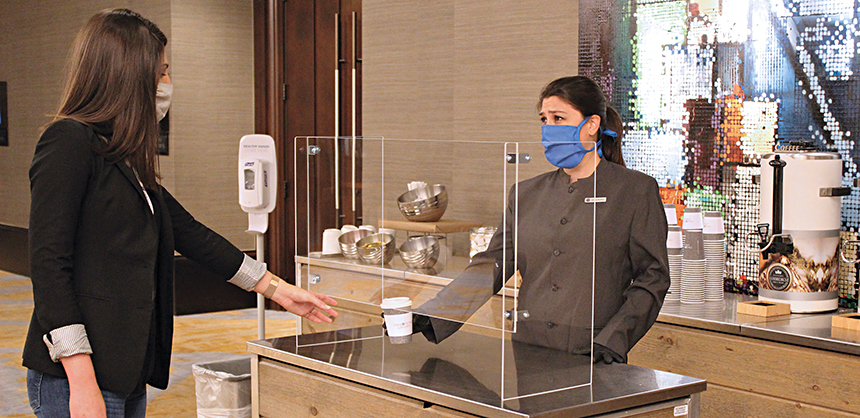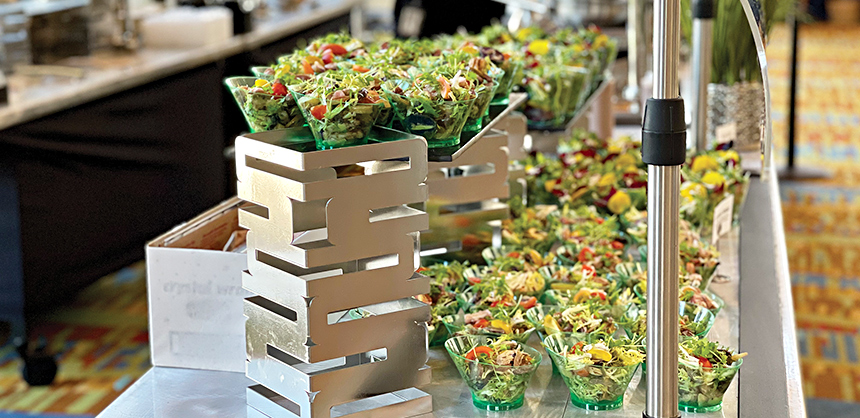Safety FirstMarch 24, 2021
Facilities Can Host Meetings With The Right Precautions By Mark RowhSafety First
Facilities Can Host Meetings With The Right Precautions
PCMA hosted its recent Convening Leaders 2021 event at the Palm Beach County Convention Center in Florida. Attendees followed strict venue guidelines for social distancing and temperature checks. Photo courtesy of Kelly Cavers
Game changer. Watershed. Sea change. Whatever words we choose to describe it, the COVID-19 pandemic has affected event planning like nothing before.
“The world of association meetings and events is changing in real time,” says Paul Miller, chief executive officer of Miller Wenhold Association Management. He notes that while the challenges are many, there is positive news as well. “Industry groups such as PCMA, ICCA and the BestCities Global Alliance have been doing a great job of keeping the community up to speed with the latest developments, ideas and strategies for adapting to our new reality.”
So just how do make sure your event is safe and secure? Thanks to the progress that has been made in recent months, planners can take advantage of a number of steps that those in charge of meeting facilities have taken in response to the challenges posed by the pandemic.
At Columbia Metropolitan Convention Center in South Carolina, which reopened last summer, a number of protocols are in place that planners have come to expect. Temperatures are checked for both staff and guests prior to entry, and masks are required at all times except when someone is actively eating and drinking. Vendor set-ups are socially distant, restrooms have been equipped to maintain a mostly hands-free experience, and the flow of events is directed to dedicated entrances and exits. In addition, maximum capacity for each event is determined by open floor-space square footage and capacity monitoring at the entrance, and cleaning schedules are customized for each event based on CDC recommendations. An added convenience for meeting planners is the ability, through a partnership with SKYNAV, to tour the convention center virtually.
Similarly motivated, the Indiana Convention Center has recently invested $7 million in health upgrades. Hospital-grade filters now circulate fresh air from outside 24 hours a day, and hospital-grade disinfectant machines clean the building throughout the day. The upgrades allowed the facility to host 21 live events in 65 days, attracting 50,000 attendees from July through September.
Other safety precautions have included creating individual rooms within the convention center for limiting attendance in each room, scheduling times for groups to arrive and depart to limit the number of people in the hallways and at entrances/exits at a given time, and installing barricades and signage to keep traffic flowing in the same direction. A recorded message plays every five minutes with directions for entrance, exit and on-site regulations. Directional signage has been expanded and enhanced with COVID-19 warnings/restrictions, and staff at the entrance to each hall with tablets to keep track of how many people are using each room.
HEALTH-CONSCIOUS HOTELS
The measures taken by hotels run the gamut from what has now become routine, to extra steps designed to aid meeting planners in careful site selection. Omni Hotels & Resorts, for example, has updated the check-in process, meeting room layouts, food and beverage services, and communal spaces, for a safer experience. These efforts build upon the American Hotel & Lodging Association’s (AHLA) “Safe Stay” program. Among other measures, Safe Stay includes reduced person-to-person contact with increased social distancing, as well as enhanced sanitation standards with cleaning products that have a greater concentration of bacteria-killing ingredients. “We believe there is a way to travel safely during these times with new initiatives in place,” says Andrew Rubinacci, EVP & chief commercial officer at Omni Hotels & Resorts. Of special interest to planners, Omni’s new social distancing filter on the meeting and event page of property websites allows users to review event spaces to ensure room for social distancing based on the number of attendees. Planners can toggle between standard, moderate and strict settings while viewing updated meeting space diagrams and enhanced visuals.
At Hyatt hotels, a “hygiene and wellbeing leader” at each property oversees safety protocols. They include enhanced business and operational practices, such as revamped food and beverage experiences, Plexiglas coverings, and signage in meeting spaces to control traffic flow and remind attendees to social distance. A hybrid meeting option supports use of multiple locations, either spread through one hotel or across several properties to accommodate social distancing, and use of technology to combine virtual and in-person experiences. Along with virtual tours, a video-conferencing platform allows hotel reps to personalize live virtual tours to customers and showcase offerings based on planners’ specific meeting needs, all in real time with planners able to ask questions.
Westgate Las Vegas Resort & Casino, which calls its approach Meet with Confidence, strives to provide a controlled, organized, and safe environment for meetings, conventions and trade shows. Protocols under this initiative include virtual site inspections and careful pre-planning of event, meal and break times, as well as pre-registration provided digitally in advance. High touchpoints are cleaned and disinfected regularly, with single-use amenities disposed of daily and hand sanitizer available in high-traffic areas. In addition to physical distancing measures, various styles of meal services are offered, with an extended menu of pre-packaged options distributed by servers.
In assessing possible venues, special recognitions may be worth considering along with AHLA’s “Safe Stay” program. For example, some venues can boast accreditation from the Global Biorisk Advisory Council (GBAC). Its STAR accreditation means facilities have met stringent protocols for cleaning, disinfection and infectious disease prevention. Among those embracing this standard are the Reno-Sparks Convention and Visitors Authority, Kentucky International Convention Center and Kentucky Exposition Center, the Gatlinburg Convention Center, and dozens of hotels and other facilities.
“During these surreal times, and perhaps on into the near future, in-person meetings should follow certain fundamental protocols,” says Lisa Anne Thompson Taylor, CEO of Board Veritas, a board governance, training and retreat management firm based in Washington, D.C. Perhaps most basic is the configuration of furniture, with each participant seated at their own, small rectangular table during sessions rather than blended eight-or 10-person round-tops. She also advises providing wellness kits to participants that blend holistic and research-based remedies for health. They might include items such as branded or attractive masks, shields and gloves with hand sanitizer that is infused with essential oils, and locally sourced or organic tea bags — individually wrapped — with elderberry or other immune-boosting ingredients. Another measure is ensuring that participants are given a one-sheet with information about nearby medical care facilities and drug stores, in case they find that help is needed.

Omni Hotels & Resorts has updated the check-in process, meeting room layouts, and food and beverage services — including using Plexiglas dividers when serving attendees — for a safer experience at the company’s hotels. Courtesy of Andrew Rubinacci
THE PEOPLE ANGLE
Of course, safe meetings depend on real-time behavior as much as advance preparation. Both attendees and event staff must share in the responsibility for protecting themselves and others. To this end, a combination of clear communication and full compliance is essential, says Alan Kleinfeld, director of Arrive Conference Solutions. “Your message has to be consistent and regular,” he says, “while it’s also important to be ready to pivot if a protocol changes.” As for compliance, everyone who attends the in-person portion of an event has to be on the same page. “If a single person isn’t willing to comply with whatever protocols you have put in place, then you can’t hold an in-person meeting.” he says. “It’s everyone or no one. Make this clear in your Duty of Care/Code of Conduct.”
Kerry Painter, director/general manager of the Raleigh Convention and Performing Arts Complex, also focuses on the importance of effective communication. “Communication is the single most important safety measure, pandemic or not,” she says, noting that a partnership between planners and site staff is critical. An open dialogue through which concerns and expectations are shared should include development of joint emergency plans for events and meetings. “The plan ensures that both parties are aligned on what to do should there be a failed health screening, a confirmed positive case, or even a non-compliant attendee.”
Assigning sufficient staff is also worth considering. “It’s been helpful for planners to have additional venue staff, event staff, or third-party staffing who can keep an eye on social distancing and mask implementation,” Painter says. In normal circumstances, planners already have so much to juggle so, in these times, making sure everyone keeps 6 feet apart and wears a mask properly is not realistic while managing all of the details of an event. “The additional staff also provide peace of mind for attendees,” she says. “They know that the planner and venue are doing their due diligence to keep them safe.”
Patrick Hardy, LL.M. CEM, CBCP, CRM, president of Hytropy Disaster Management, recommends lining up expert support. “Get an independent company, in uniform, unaffiliated with the organization, to be in charge of your COVID response and ensuring compliance,” he says. Putting this responsibility on your own staff can be a mistake, because some will bristle at the safety precautions that have to be enforced, and some will be tempted to allow colleagues to slip in. In using an external company, attendees will affiliate safety enforcement with the company you’ve hired rather than your own staff.
MOVING FORWARD
This year is expected to be a transitional one as the long-awaited preventive measures are finally in place. But despite their promise, Kleinfeld feels that vaccines won’t be the answer we’re all hoping for, at least right now. “When it comes to this virus, we know that we don’t know enough,” he says. “So keep up with reliable, respected and proven resources.”
Miller thinks that given the restrictions on receptions, large social events and other gatherings, the key for the attendee experience this year will be micro experiences. “Associations and meeting planners will need to find engaging experiences that cater to smaller audiences,” he says. “For after-hours activities, dine-arounds, and small-group beer and wine tastings will allow small cohorts to mix and mingle in a safer, more manageable way.”
He also looks for forward-thinking associations to find safe and novel ways to incorporate COVID-19-related legacy projects into meetings. “This will create unique experiences for attendees, associations and destinations that will last long after the meetings themselves.”
Planners may also want to take a look the lighter side of offerings, where feasible. For example, Kimpton EPIC Hotel in Miami adds a touch of fun to its cleaning and social distancing efforts with optional space-themed touches such as projections of space-related objects across the walls and floors, starry LED backdrops and ‘out-of-this-world” bites and drinks such as Milky Way martinis. In addition to its “So Fresh, So Clean“ program, which includes a variety of health-related strategies, the hotel has a newly renovated 14th floor, where groups can collaborate in-person in a safe environment making use of state-of-the-art tech. In addition, the hotel’s 16th-floor terrace offers an expansive outdoor setting with spectacular views of the Miami skyline.
Madeline Raithel, a communications specialist for Entire Productions, says many clients are asking for creation of fast-paced, engaging shows with games, prizes, entertainment and organizational messaging. “We are not going back to in-person events for a while, so planners need to get creative with their virtual and hybrid events,” she says. “If in-person is important to your event, then you can try some hybrid elements, such as sending a speaker to a broadcast studio.”
This is the time to leverage the entire community within a destination, says Kelly Cavers, SVP group sales & destination services for The Palm Beaches. “Health, safety, and wellness can be a top priority for a meeting, but that doesn’t mean it needs to be sterile,” she notes. That can include bringing in innovative community experiences to elevate the event experience and help accomplish event goals. While unique outdoor spaces and venues may enhance breaks and networking, adding a unique local food and beverage activation that still allows for distancing can upgrade that experience for attendees. At The Palm Beaches, formerly Discover the Palm Beaches, a “Destination Champions” program leverages local talent such as keynote speakers and artists to bring a taste of area culture to an event. Such options can help planners upgrade the meeting experience while minimizing risks.

Meals and snacks at the PCMA Convening Leaders 2021 event were individually prepared and distributed also based on strict venue and CDC guidelines. Photo courtesy of Kelly Cavers
VIRTUAL SUCCESS
With the growth of virtual meetings, an increasing concern will be the need to address cybersecurity. “Make sure you’re working with a reputable, experienced vendor and confirm your in-house IT team is up to the task,” Kleinfeld advises.
In fact, perhaps more so than in any other area, solid partnerships are a must. “As there are now so many virtual platforms, including many that have popped up since COVID-19, it’s critical to work with a partner who has experience and a proven track record of success in the virtual space,” says Catherine Chaulet, president & CEO of Global DMC Partners. Since some platforms are more secure than others, it’s important to look at options based on security concerns, such as the option to make the meeting private versus public with meeting passcodes and waiting rooms. The same goes, she adds, for making sure company firewalls do not prevent organizing and hosting virtual meetings in the first place.
Along with using an encrypted platform with passwords, Hardy says live customer service should be made available for technical issues. Insuring compliance is also vital. “Since so many breaches of IT security at events come from phishing emails, make sure that communication standards between your staff and attendees are rigorously enforced,” he says.
MOVING AHEAD
Most insiders see progress in the months ahead, but it may be slow. Kleinfeld predicts that this year will look much like last year in terms of in-person events. “Health and safety will be the major concern for travelers and planners. Get a team together, with a [COVID-19] safety officer, and move slowly from virtual to hybrid, to in-person.”
With all the complexities involved, some simple strategies may still prevail. “Common sense is key,” Kleinfeld says. “If you’re looking up and down for something new and different to battle the pandemic for your attendees or events, stop and regroup.” He recommends spending time on finding new ways to get your message out, which may include humor or fun. In the process, patience may still be in order. “Don’t rush it. Pre-COVID-sized events might still be several months away. The larger the group, the greater the chance of spread.”
Going forward, flexibility and transparency will be key considerations, Miller says. “Meeting planners that are flexible and roll with the punches in how they deliver value through meetings, while being transparent about changes and developments with attendees, will be well positioned to deliver safe, meaningful in-person events during this time of great challenges.”
Obviously, plenty of lessons have been learned over the past year. While everyone involved with events may be looking forward to a return to more “normal” times, savvy meeting planners already are thinking about applications that may be carried forward. In the near future, meetings may be largely free of the scourge of COVID-19, but the safety of participants will continue to be a top concern. Thanks to the hard work and creative thinking of many, it appears that tomorrow’s events will be safer than ever for all concerned. | AC&F |










